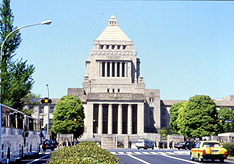| |
Constitution
Japan is a parliamentary democracy, with two houses of parliament elected by universal suffrage. The post-war Constitution, promulgated in November 1946, defines the the democratic system of government, the role of the Emperor and the rights and duties of the people.
Although Japan became the first country in Asia to introduce parliamentary politics in 1890, the upper house, or House of Peers, was made up of representatives of the privileged class; and Japan remained a monarchy, with sovereignty in the hands of the Emperor.
With the adoption of the present Constitution, sovereignty was transferred to the people. The Constitution defines the Emperor as the symbol of the state, and he has no powers related to government.
Related site: Japan Fact Sheet
|

|
Governmental Structure
The Diet (legislative branch) comprises the 480 seat House of Representatives (lower house) and the 247 seat House of Councillors (upper house). The members of the House of Representatives are elected for a four-year term, but this term may be cut short if the house is dissolved by the Prime Minister. The members of the House of Councillors are elected for fixed six-year terms, with half of the seats filled by election every three years.
The executive branch is the cabinet organised as a parliamentary cabinet system. The Prime Minister is elected by both houses of the Diet from among its members. Under the leadership of the Prime Minister, 12 ministries and agencies exist.
Judicial power has been granted to the Supreme Court and high courts as well as district and other inferior courts.
Related sites:
Japan Fact Sheet
Prime Minister's Office
House of Representatives
House of Councillors
|
Imperial Family
The Emperor is the symbol of the state and the unity of the people and has no governing power. All acts of the Emperor in matters of state are based on cabinet recommendation and approval. The present Emperor, Akihito, acceded to the throne in 1989. Emperor Akihito and Empress Michiko have three children and three grandchildren.
Related site: Imperial Household Agency
|
Flag and anthem
The Japanese flag, a large red circle on a white background, is called the Hinomaru. The sun flag has been used as a national symbol since at least the seventeenth century.
Japan's national anthem, Kimigayo, was set to music about a century ago, but the words are about 1,000 years old. They are interpreted as praying for the lasting prosperity and peace of the country. Japan's national flag and anthem were designated as such under a law enacted in August 1999.
Related site: Japan Fact Sheet
|
Regional and local government
Japan is divided in 8 regions: Hokkaido, Tohoku, Kanto, Chubu, Kinki, Chugoku, Shikoku and Kyushu. After the Meiji Restoration in 1868, the feudal domains were abolished and Japan was administratively reorganised and divided into a prefectural system. There are 47 prefectures (ken), including 1 to (Tokyo), 1 do (Hokkaido), 2 fu (Osaka and Kyoto) and 43 ken. There are 12 major cities officially designated by the government: Fukuoka, Hiroshima, Kawasaki, Kitakyushu, Kobe, Kyoto, Nagoya, Osaka, Sapporo, Sendai, Tokyo and Yokohama. At the more local level is a system of city, town, and village administrations. These municipal assemblies and mayors are also elected directly by local residents.
Related sites:
Regions and Cities
Japan Fact Sheet
Japan Atlas
|
| Top |
|
| |
|
|


